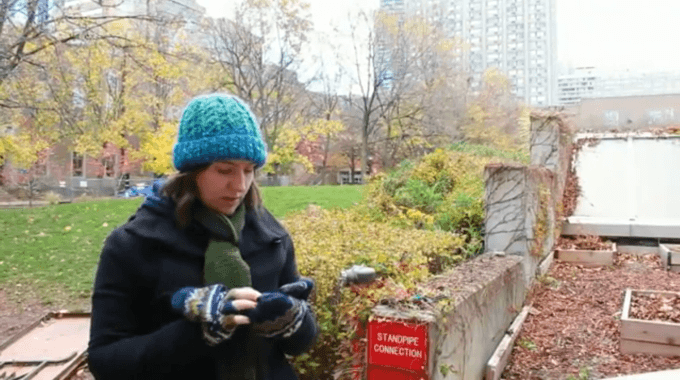Geocaching has become a popular form of adventuring in the last few years. It’s planned on the Internet, executed in secret, and the locations are limitless. Photo editor Marissa Dederer shows you how to cache on campus
[youtube]http://www.youtube.com/watch?v=QyUpu77DyMY[/youtube]
The sky is bright and the shadows long on Ryerson’s campus as I head out on my first geocaching mission.
I use mission here because I’m not entirely sure that I’m suffi ciently prepared for this treacherous journey. A toque and mitts are defi nitely in order, as are some sturdy sneakers; as you never know where a cache may take you. I start the journey, taking long and careful strides and looking up every few steps from my obliterated and diffi cult to decipher iPhone screen to avoid walking into any stray light posts or garbage cans.
Thirty seconds later, I’ve made it to within 10 metres of my destination. A message pops up on the screen, “You’re close,” it says. I feel encouraged. I take a quick survey of the area, noticing the landscape like no regular student ever would. I see the quad, a wide-open space and unlikely hiding spot. There is the Kerr Hall wind tunnel I just walked through, but there are no hiding spots there, plus it is too close to me to be accurate with my coordinates.
And there, directly in front of me, stands the façade of the Ryerson Athletic Centre (RAC), a teaser for our underground bunker of an athletic facility. To either side of the façade is nothing but path; so the arch must be my destination.
This seems too easy, I think, as there are not many hiding spots on the silly entryway. Yet I soon find out just how wrong I am. There are too many holes, fissures and corners to count – and don’t even get me started on the underbrush.
But this is a treasure hunt and I’ll be damned if I’m not finding that prize.
What started as United States Department of Defence military technology has turned into a fun treasure hunting adventure for thousands around the world. Using GPS devices, geocachers can hide and locate caches in fi elds, forests, on mountains, in the heart of a city, even in outer space.
The caches themselves can be as small as a thumbnail or as big as a shoebox. Most will contain a log, basically a guestbook, where you write to let people know you were there and some will also have prizes in them. These are sometimes big, sometimes just small trinkets, but you must replace the item with something else so the cache can continue being found. If you didn’t fi nd the cache empty, then don’t leave it that way.
Geocaching was once done most commonly in rural areas, but has been making its way into city centres. Caches are cleverly hidden but some involve an act of trust – trust that when you stick your fi ngers into that dark hole in the cement that you will get all fi ve of them back, with a newly acquired cache in hand.
Twenty-year-old Ryerson student Justine Dever-Arseneault was an avid geocacher in her high school years. According to geocaching.com, Dever-Arseneault is known as survivorgirl – she’s a big fan of the classic reality TV series and the Survivorman himself. She’s discovered more than 140 caches and she’s even hidden a few of her own. Dever-Arseneault likes that geocaching can take you outside of your usual comfort zone (rez kids, I’m looking at you) and helps you discover a new area. It’s also a lot of fun.
“There’s this saying that’s like ‘using billion dollar technology to fi nd Tupperware in the woods,” she says. “I like the whole idea of looking for something that’s hidden and like, oh, it’s a secret.” There aren’t many caches on campus, and there’s only one currently active by my count, but there are many surrounding campus. You get to walk with an unknown destination ahead of you, and unlike drunken stumbling, you’ll remember how to get back there the next morning.
***
I’m in the doorway of the façade. It’s a lot taller than you would think just walking by it. Craning my neck towards the sky I wonder if the cache is hidden high up; perhaps some climbing is in order. It’s a good thing I wore my sneakers.
Alas, common sense takes hold, the cache will be in a simple and less dangerous spot. Somewhere you have to look twice to notice.
The cache’s owner, Highfl yer55, is no geocaching slouch; they’ve found more than 300 caches and hidden 13 around the city. They’ve had practice hiding and disguising. But Highfl yer55 is kind and they’ve provided a clue.
It reads: “There is magic, but you have to be the magician. To make the magic happen you need to know that things are not always what they seem.” I have no idea what this means so I start looking in the all the places I can see, mouldy garden waste bags, rain-fi lled pails, the garden.
The cache is nowhere to be found. It’s starting to get embarrassing. It’s a good thing I’m supposed to be clandestine.
Cachers are a very close-knit community and they take pride in their secret hiding spot as they really can be quite clever. When one is caching, the “Muggles” are not supposed to be able to notice you. This term is borrowed from J.K Rowling’s memorable Harry Potter series to designate unmagical beings, and in this case designates the non-geocaching public.
If a geocache has been “Muggled,” it was compromised by a non-cacher and is no longer in play.
Currently, I am failing. Every person walking into the gym looks sideways at me, giving me quizzical looks. Even the squirrels are looking at me suspiciously. If only I had an invisibility cloak … but enough with the Potter prose.
Another quick look round of the building face proves to be futile. The cache is nowhere to be found. Geocachers are really good at hiding things, especially urbanites, who get even sneakier with their hiding spots and camoufl age.
Yet sometimes they get caught and an entire city’s attention is cast on the online community.
In May, a geocache in a west-end Toronto neighborhood was mistaken for a pipe bomb.
The cache was set up on an island in plumbing tubing, and just over a week before the incident one user on geocaching.com remarked,
“I found it a few days ago. Good cache for muggles to not realize that it is a geocache.” He turned out to be right, as Toronto Police were called in for a bomb scare and a robot was sent in to blow it up. The cache is now listed as archived on the website.
Tanya Fermin-Poppleton, manager of Ryerson security and emergency services, says they’ve never actually been aware of geocaching happening on campus.
“We would defi nitely be investigating [if it did],” she says. “Because we don’t know what they’re hiding.” She says there is the possibility that someone calls them about a suspicious package, in this case a geocache, and that starts a whole process. From calling for backup to a bomb squad, things can quickly get messy.
“We would do the same thing we would do for any type of suspicious behaviour: [try] and get answers to what’s going on,” says Fermin Poppleton.
She says she’s not sure if the university would be willing to participate in being a location for geocaching, as it is here for educational purposes and this could result in noncommunity member on campus, as well as suspicious package scares.
The area around campus is city property and therefore Ryerson wouldn’t have jurisdiction, she says, but they could let the university or the department know that people will be looking around in their area.
In reality, warning people would ruin the secrecy and game aspects of the hunt and geocaching is currently happening on campus.
In fact, it’s happening right now, as Dever Arsenault leads me back to the RAC. I’ve asked her to help me fi nd the unwinnable cache. This was the fi rst one she found on campus and it sticks out in her mind. She stands idly by while I continue to struggle. She fi nally takes pity on me and stands next to it looking pointedly in its direction.
Finally I see it! The cache is so obvious! How had I not noticed it before? Well perhaps I was so used to not really looking at what was right beneath my eyes.










ralph lauren basket
Intriguing column , I am going to spend a lot more time reading about this topic